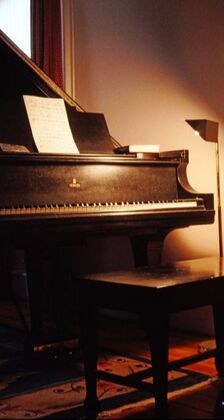 Last month I reviewed some technologies for online teaching. summer-thoughts-on-online-music-learning.html Since writing, Zoom’s September update (5.2.2) has greatly improved its sound quality for music-making. So I thought I would update you on results from testing the different options outlined in the first paper, and review the Zoom update. Last month, I recommended using two platforms together in lessons – Cleanfeed/iMidi for audio and Jitsi Meet for video[2]. I still consider these to be the best options but the picture is more nuanced now. I have tested each of these, plus the ‘hi-fi’ options in Zoom’s update, and identified other aspects of your set up that you may like to change to transmit better sound[3]. Please note that even if you update your Zoom client, you will not automatically get better sound, so this paper also covers the easy steps for setting up Original Sound in the new versions.
Methodology Excerpts of performances of same piece, selected for its range of register, dynamics and resources, were recorded during the early afternoon at a weekend. Three different microphones were used, three platforms (two with configuration options) and two different browsers were used. The device used was a Windows laptop with ethernet cable connection to the internet. Conclusions: Microphones and headphones The weak link in most people’s set up is the integral microphone in the device. Even most separate webcams have very basic microphones, designed for voice conferencing. I use a Q2N USB webcam with a mic designed for music. This retails at around £150, but even a £30-£40 mic is likely to be an improvement on what is in your phone. Please remember that a microphone, rather like a face covering, mostly benefits the person you are communicating with rather than yourself. To an extent, this is true of headphones as well. Headphones are worn to benefit the other person in the lesson, by cutting out echo and feedback for them, at least as much as they are used to deliver clear sound to your own ears. Just as for the microphone, any set of headphones is better than none, but bluetooth headphones may add to the 'lag' you experience. 1. Review of Zoom update 5.2.2. Zoom’s update to 5.2.2 has improved sound quality for music-making. To download Zoom, go to zoom.us and follow on-screen instructions If you previously downloaded Zoom before September this year, update to 5.2.2 by opening your zoom client on your device. Click your profile icon (top right), choose Check for Updates, and follow on-screen instructions. To update Audio, click the Settings gear (top right), choose Audio and Advanced. Keep Echo Cancellation at Auto and tick all other options. *Please note the warnings under the question marks – they mostly make the same point as I do in section 6 of this paper, ie connect by ethernet not wifi. 2. Trial results: Zoom with Cleanfeed This option uses Zoom for video only. See Section 4 for audio test results. 3. Trial results: Jitsi Meet on its own In summer lessons, pupils mostly reported slightly improved sound, but this was in comparison with the older version of Zoom. 4. Trial results: Cleanfeed (with either Jitsi Meet or Zoom for video) The set up and joining instructions took some getting used to, but I have now set up a unique link for every pupil. Cleanfeed performed well in tests, and all summer lesson pupils reported better sound. Cleanfeed is at its best when: There are ‘fixes’ available in Cleanfeed to repair the sound if headphones cannot be worn, but in some cases this appeared to reduce the sound to levels at or even below those of Jitsi and the latest version of Zoom. There is more video lag with Zoom, but screen sharing options and additional cameras are easier to set up. How much this matters to you will depend how helpful you find the Classroom Maestro keyboard demos, so please do complete the survey on this. 5. Trial results: Internet Midi Internet Midi sound is as good as your digital piano. Any variance in results from using different conferencing options will be reported on later. 6. Trial results: ethernet connection An ethernet connection will improve whichever options you choose, but is essential if you stay with Zoom. This is because Cleanfeed and Jitsi are 'peer to peer' connections, meaning that signals go directly between users. Zoom works by sending data in to a central server and out again. Packeting audio and video together will also contribute to lag and screen-freezes, and the upgraded ‘hifi’ sound is known to be heavy on bandwidth. Jitsi, Internet Midi and Cleanfeed are secure, in part because they are ‘ephemeral’ connections and so there are no 'rooms' to be hacked into. Passwords will be used for all platforms and students under 18 will connect and work under the supervision of a responsible adult. Bibliography As for the original paper, I draw here on the work done by Dr Ian Howells from the New England Conservatory of Music and additionally on work done by the European Piano Teachers’ Association (EPTA-UK). Ian Howell, June 2020, “Technology Enabled Music Lessons” https://www.ianhowellcountertenor.com/technology-enabled-music-lessons (accessed August 3, 2020) Cleanfeed Knowledge base, 2020, “Eliminating echo” https://cleanfeed.net/knowledge/eliminating-echo (accessed August 5, 2020) Timewarp Technologies, 2020, “Introduction to Internet Midi”, video tutorial https://timewarptech.com/introduction-to-internet-midi/?v=79cba1185463 Timewarp Technologies, 2020, “Using Internet Midi with Video Conferencing software”, video https://timewarptech.com/using-internet-midi-with-video-conferencing-software/?v=79cba1185463
0 Comments
 Zoom's sound quality for music-making, even when corrected to Original Sound, continues to be quite poor. With the update from August 2020, this has been further degraded. While it may be an acceptable experience for a 30 minute lesson once a week, supported by re-lesson recordings and other workarounds, I am finding it intolerable for the up to 30 hours a week I need to be using it. I have carried out a risk assessment. As schools return, as a private tutor I consider myself to be a nexus for ten different schools, rather more year group cohorts. I am investing in screens, sanitizer etc, and changing my working practices. However, from September, I plan only to offer face to face teaching to households I consider to be very low risk, such as home educators. With on-line lessons being at least part of the landscape for the foreseeable future, I feel we need to find the best technical solutions to help us develop as musicians and enjoy our music making. I have therefore spent some considerable time researching better options for teaching over the summer months. This paper draws in particular on the work done by Dr Ian Howells from the New England Conservatory of Music. From a growing and competitive field I have selected and trialled three new solutions:
Why change?Both Cleanfeed and Jitsi are 'peer to peer' connections, meaning that signals go directly between users rather than by way of several nodes of a network to a central server and out again, as for Zoom and most other video-conferencing platforms. The way in which Zoom packets audio and video together also contributes to its lag and screen-freezes. Both Jitsi and Cleanfeed are secure:
1. First option: Zoom on its own (change nothing) Stay as we are – Zoom on a variety of devices. I will continue to run a Pro licence and can go back to it any time we need to. Change is only worth doing if it adds value. However please bear in mind that Zoom sound quality for music was downgraded in the latest release, with Original Sound now a diminished ‘tweak’ to audio settings. If Zoom sound was bad for you before, it is going to get worse. 2. Second option: Zoom with Cleanfeed Basically this would use Zoom for video only, without audio, so scroll down to Section 4 for instructions on this option. 3. Third option: Jitsi Meet on its own If you only use iphone/ ipad for lessons, we can compare Jitsi in a browser with Zoom. There will be an extra bit of coding in the link I send you, designed to optimise Jitsi for music. It’s slightly different depending on whether or not you use headphones - I recommend you do if you can[1]. See Option 4 if you would like to try Cleanfeed – some set up required by you. 4. Best option: Cleanfeed & Jitsi Meet, or Cleanfeed & Zoom This is the better choice – if we can make it work. It makes use of Cleanfeed for audio and Jitsi for video and screen share. I have also had good results using Cleanfeed for audio and Zoom, muted, for video – there is more video lag with Zoom, but screen sharing options and additional cameras are easier to set up. How much this matters to you will depend how helpful you find the Classroom Maestro keyboard demos. If you use a computer, mac or tablet set up is quite simple. If you use an iphone or ipad there is a little more set up required (see 4.2 below). 4.1. Cleanfeed plus Jitsi set up: For desktops, laptops, tablets and mac, with headphones
4.3 Cleanfeed plus Jitsi/Zoom: For iphone and ipad, with headphones If you use iphone or ipad, and are prepared to do a little bit of set up before the lesson, we can still do it. It should be worth it! You will need headphones, and an adapter so you can connect both headphones and your charger at the same time – this arrangement uses a lot of battery. The basic idea is that you need to connect to Cleanfeed first, then start the video meeting in Jitsi/Zoom. You then need to restart the audio in Cleanfeed, and return to the video lesson. 5. Option for midi keyboard users If you have a midi cable socket on the back of your keyboard and a budget of about £40, we can play each other’s keyboards at a distance. This is great fun, but also really useful for teaching and learning. I can see onscreen the keys you are pressing, you can see mine. We can duet, record, even generate notation. There is almost no lag, and the quality will be as high as the sampling of your keyboard allows. The investment is for a midi to PC/ iOS cable, plus a software download called Internet Midi form TimeWarp Technologies, normally $60 but half price until the end of September 2020. https://timewarptech.com/shop/music-software-apps/software/internet-midi/?v=79cba1185463 We could use Internet Midi in a Zoom meeting, using Zoom for the video and voice audio connection, and Internet Midi for the music. There would be no need for Cleanfeed. As you will appreciate, I have not suggested any solutions up to now that were going to cost you to install, but this option is really very special indeed, so if you can afford it I don’t think you would regret it. 6. Option for everyone: improved connection with ethernet Please try to use ethernet cables to connect to the internet if at all possible. 7. Bibliography Ian Howell, June 2020, “Technology Enabled Music Lessons” https://www.ianhowellcountertenor.com/technology-enabled-music-lessons (accessed August 3, 2020) Cleanfeed Knowledge base, 2020, “Eliminating echo” https://cleanfeed.net/knowledge/eliminating-echo (accessed August 5, 2020) Timewarp Technologies, 2020, “Introduction to Internet Midi”, video tutorial https://timewarptech.com/introduction-to-internet-midi/?v=79cba1185463 Timewarp Technologies, 2020, “Using Internet Midi with Video Conferencing software”, video https://timewarptech.com/using-internet-midi-with-video-conferencing-software/?v=79cba1185463 [1] Earbuds do not work as well, as they don’t allow you to hear clearly the sound in the room. Both wi-fi and Bluetooth earphones are to be avoided for on-line lessons [2] The way that Jitsi Meet handles audio for music is far from perfect, especially on the iPhone app, seeming to 'vanish' the url tags. Jitsi Meet in an iPhone browser performs better. [3] There are other possible reasons for echo: see this knowledge-base article for other solutions to try if this does not fix the problem |
AuthorNews and thoughts from the piano bench Categories
All
Archives |

 RSS Feed
RSS Feed
